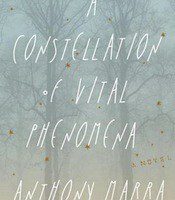Some novels defy gravity, spanning years and crossing ruined landscapes and entire solar systems of characters while still maintaining an ethereal, almost impossible lightness. Anthony Marra’s debut novel is one of them, and it does indeed call to mind an astronomical marvel. Taking place in war-ravaged Chechnya across a decade, A Constellation of Vital Phenomena is a stunning debut, following a timid but determined country doctor and the girl he rescues once her father is arrested and presumably killed. Marra elegantly slides across time and perspective, mastering an omniscient voice that reveals each character’s future, present, and past, all in acrobatic sentences that leap through time.
Marra’s Chechnya calls to mind novels that conjure cataclysm, placing characters within a post-apocalyptic landscape. However, when the cause of the ruin is political and when the threat of forced disappearance lingers, those who survive not only have to adjust to a daily culture of fear, but also are haunted by history. In the opening of the novel, Akhmed, our doctor, weaves a serpentine route through a frozen forest as he takes the girl, Haava, to a hospital where he hopes she will be safe from the agents who made her father disappear. On their way, Akhmed—who, as a medical student skipped labs to audit drawing classes—passes weathered drawings of disappeared villagers, and readers learn that “two years earlier, after forty-one of the villagers had disappeared in a single day, Akhmed had drawn their forty-one portraits on forty-one plywood boards…and hung them throughout the village.” While an incompetent doctor, Akhmed is a fierce defender of memory and history. When he and Haava’s father gave shelter to refugees, Akhmed earned his living listening to the travelers describe the faces of their disappeared relatives, which he then drew from their memory—a police sketch artist in a time of war. Akhmed is sensitive to the legacy of the disappeared, honoring them with his small rituals and risking his own life to save Haava.
Throughout Constellation, Marra emphasizes the interconnectivity of memories and personal histories. Each character, regardless how seemingly insignificant, is given a rich history and a curious future, which Marra dispenses with the nonchalant mysticism of a soothsayer. Not only does this concern for consequence reveal the futures and hidden pasts of every passing stranger, every hospital patient, every illegal gun runner, but Marra also imbues physical objects with their own past lives. When Sonja, the head doctor at Hospital 6 where Akhmed hides Haava, buys an ice box, we are given a glimpse of even the ice box’s former life: “Three half brothers, now sixteen, eleven, and eight, had been conceived on that steel lid, none yet aware of the others’ existence.” With a deftness and constant wonder, Marra brings dignity with the details, envisioning not a flattened, devastated country, but rather one where the history of things is tenacious, where the disappeared are not forgotten, and where everything has a second life.

The story of Akhmed’s attempts to keep Haava safe is the unifying thread of the novel, which also follows the storyline of Sonja, the hardened doctor who has performed over a thousand leg amputations, and Khassan, a man in Akhmed’s village who has been writing and rewriting a history of Chechnya for over thirty years, among other characters. Just as both place and auxiliary characters are charged with the kinetic energy of their future and past selves, so does each chapter reveal an impressive depth of character while also maintaining forward movement. As the only doctor in an abandoned hospital, Sonja numbly performs gruesome operations on victims of land mines while she waits for her vanished sister to return. Khassan wanders his village with a pack of dogs as his only friends, as he is shunned for his cowardly son’s work as an informant. Meanwhile, Akhmed works at Sonja’s hospital in order to repay her for keeping Haava, growing more confident as a physician while also facing new horrors each day.
In each change of perspective, Marra reveals characters who are both exhausted by loss and resilient. In Haava, Sonja, and Akhmed, Marra creates three unique ways of confronting the aftermath of loss and the daily realities of war. A child of eight, Haava is playful but precocious, wary of adults and pining for her father. Even Akhmed, who is initially teased by Sonja for being too sensitive, is far from paralyzed by the disappearance of his closest friend, the illness of his invalid wife, or the risks of keeping Haava safe. When Haava’s home is destroyed, he immediately takes care of the girl and decides to bring her to Sonja’s hospital. As they pass the hissing embers of Haava’s home, Akmed caustions Haava against harboring nostalgia:
“That’s my house.” Her voice broke their silence and he heard it as he would the only sound in an empty corridor.
“Don’t think of it like that,” he said.
“Like what?”
“Like it’s still yours.”
Marra’s characters are constantly aware of the transience of things, the frailty of their lives. This leads both to a resolve and poignancy that pervades the novel, as each character reckons with the inevitable. Living in a country where land mines can destroy lives in seconds, where people can disappear into the back of a truck, Sonja, Akhmed, and Haava are haunted by the past and aware that their lives could be cut short at any moment. Marra plays with this tight cord of tension throughout the novel; despite the poetic gestures of remembrance and the moments of beauty in the rubble, the reader cannot break free from the fear of bombs underfoot. This urgency is the driving force of Marra’s novel, as the characters skirt tripwires and evade checkpoints, carrying with them memories that promise to survive.




